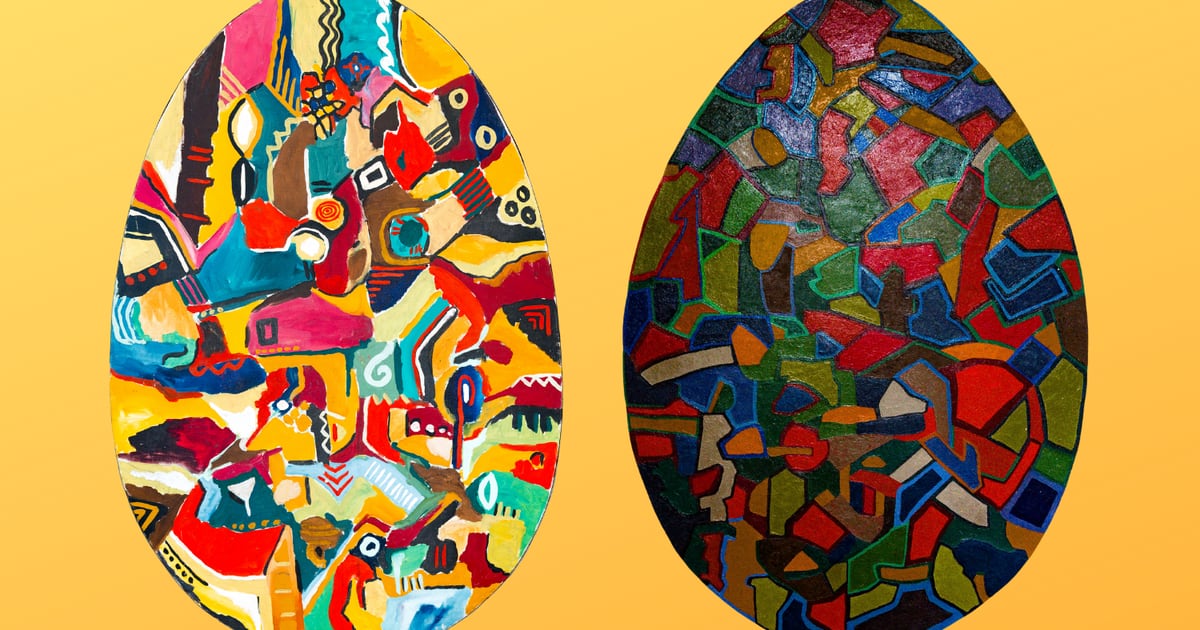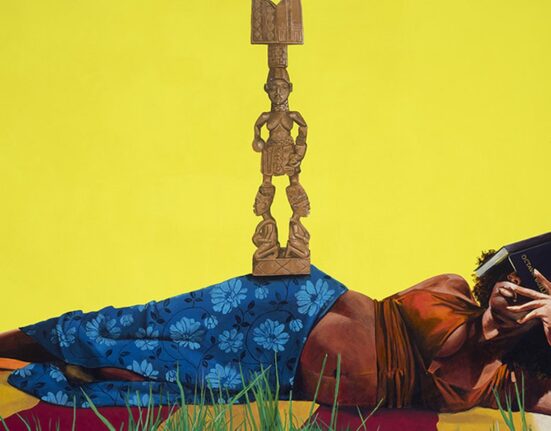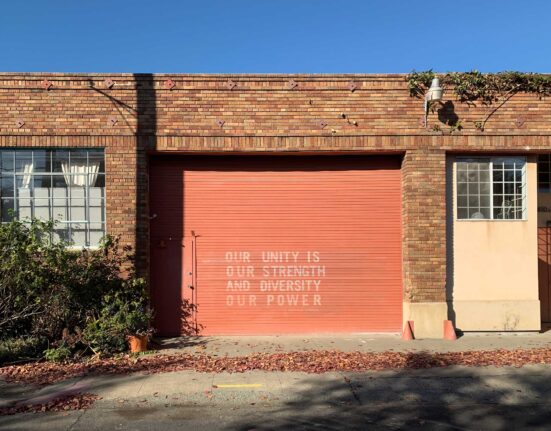Why not adapt her dentist’s practice of shuffling back-and-forth among patients in various treatment rooms to her own artistic endeavors? Why not set up stations in her home so she could continuously move from one art project to the next?
That’s exactly what she did: You’ll see the results when you stroll through the colorful special exhibition galleries at the Dayton Art Institute where “The Artistic Life of Aka Pereyma” will be on display through May 12.
“My mother never suffered artist’s block,” says Aka’s daughter, Vaka. “If one area wasn’t going well, she would just move to another.”
Pereyma, who lived in Troy much of her life, was best known for her delicate Ukrainian eggs. What’s less known? Throughout her lifetime, she also created folk art in a wide variety of other mediums — metal sculptures and oil paintings; needlework and woodblock prints; ceramics and drawings. All of them are imbued with her love of her native Ukraine and all are represented in the colorful DAI show.
Those who knew her say Aka was as colorful as her artwork.
“She was a force of nature,” said her daughter, Christina. “Nothing intimidated her. “
Vaka remembers being picked up after school by a mother who arrived in a flaming red station wagon wearing pink overalls. “Not many moms were attending art school while their children were in elementary school,” she notes. “If she’d been welding, she’d show up with soot all over her face and white eye sockets from wearing goggles.”
Carrying on a tradition
Since Aka’s death in 2013 at the age of 86, daughters and Christina’s daughter, Helen, have carried on her legacy by promoting her work and teaching others how to decorate the special eggs. Known as “pysanka,” the intricate eggs are thought to have originated in pre-Christian times and were traditionally given mythological powers and used as talismans to ward off misfortune.
Vaka often shares an ancient folk tale.
“It says as long as somebody is decorating the eggs, the monster of the world who is chained to a mythical mountain cannot get loose and destroy the world.,” she said.
The eggs have taken on added significance since February 2014 when the international conflict between Russia and Ukraine began.
“The truth about eggs is that they are fragile and everything now is very fragile,” Christina told participants at Springfield’s Westcott House last March while teaching them how to make the Ukrainian eggs. “So Russia trying to break Ukraine is very symbolic. Right now, it’s possible that women in the west of Ukraine are decorating eggs, but people who are refugees and in a war zone are not. People who are fleeing can’t sit and do this peaceful activity.”
Pereyma family members are thrilled at the DAI’s recognition of their matriarch’s talent. The folks at the DAI are just as enthused.
“I’ve never seen our staff so excited about an exhibit,” said chief curator Jerry N. Smith, who was introduced to Peryema’s work when her family invited him to their home in Troy three years ago along with DAI director Michael Roediger.
“She was a visionary,” says Smith, who was blown away by the art. “You see this clear confidence in the work, there’s nothing timid about it, whatever the medium. It is forceful, intentional, resolute and informed.”
This isn’t the first time Aka has been connected to our local art museum; she received a degree in sculpture from the School of the Dayton Art Institute in 1966.
A family history
Aka Pereyma was born in 1927 in Poland to Ukrainian parents and relocated to Ukraine in 1940. In 1944, she and her family moved to Austria and soon after to Germany where she met and married Dr. Constantine Pereyma. In 1950, the couple immigrated to the United States, settling first in Buffalo and Brooklyn.
When her husband was busy with his medical training, Aka explored art galleries and museums in New York City. When she began making art herself, her husband encouraged her to attend classes.
In 1959, the family moved to a farm in Troy. In addition to receiving a degree from the DAI art school, Aka studied at the Art Institute of Chicago. In 1967, she learned artistic welding and served as artist coordinator for the Welding for Artists Program at the Hobart School for Welding Technology in Troy.
Pereyma regularly exhibited her art locally, nationally and internationally. In 1983, she became a citizen of the United States, was inducted into the Troy Hall of Fame at the Troy-Hayner Cultural Center in 1997 and, in 2001, was recognized with a decree by the President of Ukraine as an “Honored Artist of Ukraine.”
When an exhibit of Aka’s work was shown at Chicago’s Ukrainian Institute of Modern Art, she told a reporter that several of the works were inspired by Ukrainian folk songs that her mother sang to her as a child. She was labeled a “living cultural treasure” in 2003 when she was honored by the Ohio Arts Council in the first group of Ohio Heritage Fellows.
“She has served as a creative repository of the visual symbolism of Ukrainian culture, much of which was lost in the 20th century,” they said, adding that her work in the Ukrainian pysanky decorated egg tradition was “of the highest quality to be found anywhere in the world.”
After Ukraine became independent in 1991, Aka and her sister, Tanya, traveled there many times with the Cultural Minister of Ukraine, Oleksandra Fedoruk. “He wrote the first book about my mother and the title is ‘The Extraordinary World of Aka Pereyma.’ ” Christina said. “Everything about her was extraordinary.”
Her daughters say whenever and wherever their mother faced a life challenge she would always say: “We survived Stalin, we survived Hitler, so we can survive this, too.”
Christina says although her mother always honored her ties to Ukraine, when speaking publicly she always acknowledged that she would never have been able to live such a fantastic life of prosperity and peace if she hadn’t lived in America.
What you’ll see
This retrospective exhibition brings together Pereyma’s work from the early 1960s to the 21st century. Much of it is quite personal.
You’ll see artwork inspired by Ukrainian folk songs and stories, depictions of birds that reflect Pereyma’s love for nature, Adam and Eve images that symbolize men and women. You’ll see images of family members and, no surprise, you’ll see a wide variety of eggs and egg-related images.
Don’t miss the video where you’ll get a chance to hear from the artist herself.
Other special delights:
- The wall of welded birds made from discarded farm tools. Some represent birds on the family’s farm; others are inspired by birds in the Ukraine.
- The hand-carved chess set and painted toy blocks. Pereyma believed in making her children’s playthings rather than buying them in the store. As a result, the children grew up believing that something made by hand was better than what was store-bought.
- A sculpture of Marian Anderson who performed at an open-air public concert held on the steps of the Lincoln Memorial after being denied the opportunity to sing at the Daughters of the American Revolution Constitutional Hall in DC.
- Aka even designed the memorial gravesite in Troy for herself and her husband. You’ll see a model of the memorial at the exhibit.
Aka never felt a work of art was finished and never hesitated to embellish it. When others said “Less Is More,” Aka was always quick to correct them. “More is more!” she insisted.
Aka, who began creating the Ukrainian eggs at age six, always believed that those who practice the ancient art of pysanka, are communicating with their eggs. “It’s profound and magical, a connection to the spirit of rebirth,” Christina says. ” It’s a new life coming from an inert object. If you ever saw a baby chick emerge from the egg, you know it’s magic!”
How to go
What: “The Artistic Life of Aka Pereyma”
Where: Dayton Art Institute, 456 Belmonte Park, Dayton
When: 11 a.m. to 5 p.m. Wednesday, Friday and Saturday; 11 a.m. to 8 p.m. Thursday and noon to 5 p.m. Sunday
Admission: $15 for adults, $10 for seniors, active military and groups of 10 or more; $5 for college students and youth. Museum members and Children ages 6 and younger are free
More online: daytonartinstitute.org
Related programming
Unless noted, these programs are free of charge with museum admission:
- Community Guided Tour: Select Saturdays, March 9, April 20 and May 4, from 1:30–2:30 p.m. and Select Thursdays, Feb. 29, March 28 and April 25, from 6-7 p.m.
- Curatorial Conversation: 1:30-2:30 p.m. March 30
- Exhibition Speaker Series: Iryna Voloshyna: 2–3 p.m. March 16
- Exhibition Speaker Series: Christina Pereyma O’Neal: 2-3 p.m. April 13
- Experience the Exhibition: Ukrainian Egg Painting: 1:30-3 p.m. March 23. $35 for members and $45 for non-members
- Experience the Exhibition: Family Story Telling: 1:30-3 p.m. April 27. $35 for members and $45 for non-members







